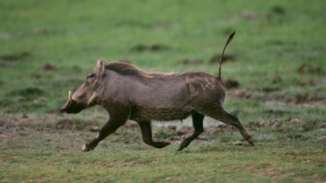
猫鼬与疣猪的奇妙共生关系
Mongooses Pile on Warthogs--to Groom Them
猫鼬与疣猪的奇妙共生关系
In the first known example of a mutualistic relationship between two mammal species in which neither is a primate, mongooses feast on ticks and other parasites infesting warthogs.
猫鼬(Mongooses)以舔食疣猪(Warthogs)身上的虱子为生。这是首次在非灵长类动物中发现的,两种不同哺乳动物之间的共生关系。
撰文/播音 Jason G. Goldman
翻译 Meatle
审校 吴非
Mutual relationships are common throughout the animal kingdom. Fish called remoras get a tasty meal by picking bits of dead skin and parasites off of sharks, while the sharks enjoy their undersea spa treatment. Birds called oxpeckers gobble ticks off the skin of rhinos and zebras. Pollinators like bees and butterflies help flowers to reproduce while getting a tasty treat.
在动物王国之中,共生是一种常见现象。鮣鱼(remora)靠吞食鲨鱼体表的死皮和寄生虫维生,鲨鱼也享受这种spa服务。牛椋鸟(oxpecker)啄食犀牛和斑马身上的虱子。蜜蜂和蝴蝶等传粉昆虫在帮助植物授粉的同时享用着美味的花蜜。
And now we have evidence for an unusual mutual relationship—between warthogs and banded mongooses.
现在,我们发现了一种不常见的,存在于两种哺乳动物之间的共生关系——疣猪和猫鼬的共生关系。
Packs of mongooses will pile onto warthogs to pick blood-filled ticks and other parasites from the warthogs' fur. The hogs get cleaned up while the mongoose get fed. Everybody wins—well, except for the ticks.
疣猪的身上堆满了猫鼬,后者享用着前者的皮毛之间充满血的蜱虫等寄生虫自助餐。疣猪的皮肤得到了清理,同时猫鼬享用到食物,大家都得到了好处。当然,寄生虫除外。
"Quite often the warthog will then lie down and actually lift its legs, and they'll swarm all over them. In these groups you've got 15 to 20 individuals and they can just cover the warthogs."
Wildlife Conservation Society researcher Andy Plumptre, who documented the warthog-mongoose mutualism in Uganda's Queen Elizabeth National Park. He published his observation in Suiform Soundings, the newsletter of the International Union for Conservation of Nature's Specialist Groups for Wild Pigs, Peccaries, and Hippos. [Andrew Plumptre, Banded mongooses grooming warthogs]
“通常,疣猪会躺下并抬起四肢,这时候猫鼬们就会蜂拥而至。这样的一群猫鼬通常有15-20只,它们将疣猪‘淹没’。”国际野生动物保护协会(Wildlife Conservation Society)的研究员Andy Plumptre说道。他在乌干达的伊丽莎白国家公园(Queen Elizabeth National Park)中记录下了疣猪-猫鼬的共生实例,Plumptre将结论发表在Suiform Soundings上,这是由联合国的世界自然保护联盟创办的报刊,致力于对野生猪类、野猪和河马的保护。
Mutualism is obviously common in nature, but it's uncommon to find it between two different mammal species.
共生关系在自然界颇为常见,然而两种不同的哺乳动物之间的却甚为罕见。
"I've heard once of somebody who saw a red-tailed monkey grooming a juvenile chimpanzee…and after the article came out, somebody contacted me and said they'd seen vervet monkeys grooming impalas."
“我曾听说有人目击了一只红尾长尾猴(red-tailed monkey)帮助另一只未成年的黑猩猩(chimpanzee)清理毛发…而在我们的文章发表后,有人联系我们称他们曾经看到过长尾黑颚猴(vervet monkeys)帮助黑斑羚(impalas)理毛。”
So such behavior obviously does occur among mammals, but seemingly rarely. And the warthog-mongoose connection is the first example we know of that does not include a primate.
看来这种行为确实会偶尔在哺乳动物间发生。另一方面,疣猪-猫鼬的关系也是我们所知的,不涉及灵长类动物的首个实例。
"So the mongoose researchers, they're all aware about it and will happily tell you about it, but nobody seems to have picked it up as a topic of research and actually looked at it in more detail."
“对于猫鼬研究者而言,他们早已发现了这种关系,他们也会乐于与你谈及这种现象,但貌似没有人以此作为研究的主题并研究其中的细节。”
For example, it’s unclear if the interaction is instinctive or must be learned, whether it only occurs at certain times of year and so on. Given how long folks have been observing African wildlife, this begs the question: what other surprising animal behaviors are hiding in plain sight, waiting to be formally described in the scientific literature?
很多问题仍尚未明缺,比如,这种关系是天生的还是后天习得的,这是否只出现在一年中特定的时间段内。想想,我们已经在非洲做了那么多年的生态观察了,是否该问一下:还有多少令人称奇的动物行为隐藏在这片平原之中,等待我们细致观察与严肃讨论呢?
未经书面许可任何人不得复制或镜像
京ICP备11000850号-1
 京公网安备11010502039775号
京公网安备11010502039775号 信息网络传播视听节目许可证0111611号
国家科技基础条件平台

















